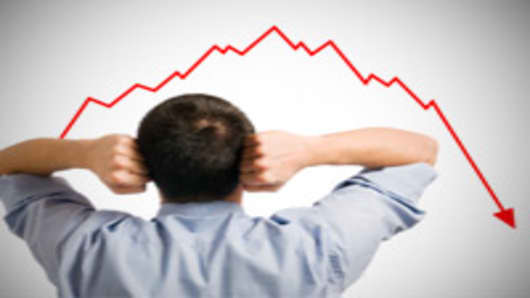Commodities prices have been in freefall in recent weeks—a victim of money fleeing risk assets, technical resistance and Federal Reserve actions that finally seem to have lost their impact.
The commodity story is part of a larger narrative in which investors have become increasingly cautious as 2012 winds to a close, pulling money from the markets and causing drops across most investments other than bonds.
The looming fiscal disaster in Washington coupled with the seesaw presidential election and the European debt crisis have been persistent thorns for investors.
(Read More: 'There Will Be Compromise' on the 'Cliff': Blankfein)
Toss in a weak earnings season and the inability of the third round of the Fed's quantitative easing program to make inroads on its goals, and the markets are setting up for a fourth-quarter flu that may be hard to cure.
Traders who thought global growth and easy monetary policies from central banks would translate into big commodity profits are heading for the sidelines, said Kevin Ferry, president of Cronus Futures Management in Chicago.
"If this is real fundamental selling and if these guys got it wrong and now they're bailing out of the commodity market and that's telling you that globally we've hit stall speed, then watch out," he said. "If you put $3 trillion on the Fed balance sheet and you can't point to the inflating asset class, then you're going into the abyss."
Indeed, Fed QE policy was based largely on generating so-called good inflation — pumping liquidity into the market that would be used to buy stocks and commodities, generating what Chairman Ben Bernanke likes to call a "wealth effect" that pushes growth. (Read More: Fed Holding Firm With Help to Slow-Growth Economy)
All of the inflation so far, though, has been the unpopular kind, in which gasoline prices soared past $4 a gallon — $5 in California — and food prices have continued to creep up as well even as the overall inflation rate has stayed around 2 percent.
The desired effect of pushing the housing market higher, meanwhile, has seen mixed results, with mortgage rates actually moving higher and home loan volume tailing off in recent weeks.
"You can print all the money you want, but it won't matter if there's no one there to buy what you're selling," Ferry said.
The commodity dip has been about more than the Fed and its money-printing, though. There's a political angle as well
Prices began sagging in mid-September — right about the same time President Barack Obama's probability of re-election began a fairly precipitous dip at online betting site Intrade, according to Julian Jessop, head of commodities research at Capital Economics.
The endangerment of the commodity-friendly administration has been at least part of the story behind the drop, Jessop said.
Under this line of thinking, the market is anticipating that Republican challenger Mitt Romney might pressure the Federal Reserve to begin tightening the money supply and pushing for a stronger dollar. There's even thought among traders that he would go as far as to try to push Chairman Ben Bernanke to step aside and appoint a strong-dollar proponent such as Stanford economist John Taylor.
A weak greenback favors commodities because they are priced in dollars and thus cheaper against global currencies. When measured against a basket of the world's currencies, the dollar has fallen about 10 percent since its peak early in the Obama administration.
"As it happens, commodity prices have tended to rise and fall with the perceived chances of an Obama victory," Jessop said in a report. "But this surely reflects the fact that both have been driven primarily by a third factor — namely the news on the economy — rather than any market preference for Obama."
Indeed, the 7 percent drop in the Goldman Sachs Commodity Index has been about double the loss in the Standard & Poor's 500 since the Sept. 14 highs, but at least has been directionally the same.
Both are about a renewed round of risk aversion in the markets, where money is now heading toward the sidelines again.
Cash balances in money market funds have been on a gradual creep higher since late July, now totaling $2.57 trillion, according to the Investment Company Institute. (Read More: Companies Are Sitting on More Cash Than Ever Before)
At the same time, the $5.5 trillion mutual fund industry continues to hemorrhage funds on the equity side, with stock-based offerings losing $15.5 billion in October alone, while bond funds have seen nearly $28 billion in inflows.
The story is the same inside corporate America, where the sentiment, if not outright fear, is at least an unwillingness to take risk.
Corporate selling of stocks totaled $66.8 billion against buying of $40.3 billion since the beginning of September, the biggest gap since late 2010, according to market research firm TrimTabs.
Charles Biderman, CEO at TrimTabs, said the trends for risk are not encouraging.
"With the presidential election and the 'fiscal cliff' approaching and the global financial system on life support from central banks, corporate insiders seem to be battening down the hatches," he said in his weekly report. "We expect economic growth to slow heading into the holidays."



